Palma de Mallorca
Palma | |||
|---|---|---|---|
City and Municipality | |||
| Palma | |||
 View of Palma Bay, from Bellver Castle | |||
| |||
| Nickname(s): Ciutat de Mallorca (commonly shortened to Ciutat) | |||
 Palma shown within Mallorca | |||
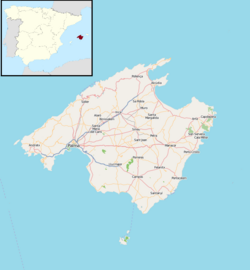 Palma Palma shown within Spain Show map of Majorca  Palma Palma (Balearic Islands) Show map of Balearic Islands  Palma Palma (Spain) Show map of Spain | |||
| Coordinates: 39°34′N 2°39′E / 39.567°N 2.650°E / 39.567; 2.650Coordinates: 39°34′N 2°39′E / 39.567°N 2.650°E / 39.567; 2.650 | |||
| Sovereign state | |||
| Autonomous community | |||
| Province | |||
| Island | |||
| Comarca | Palma | ||
| Judicial district | Palma | ||
| Founded | 124 BC | ||
| Administrative HQ | Palma | ||
| Government | |||
| • Type | Municipal corporation | ||
| • Body | Ajuntament de Palma | ||
| • Mayor | Antoni Noguera Ortega (Més) | ||
| Area | |||
| • City and Municipality | 208.63 km2 (80.55 sq mi) | ||
| Elevation | 13 m (43 ft) | ||
| Population (2009)[citation needed] | |||
| • City and Municipality | 401,270 | ||
| • Density | 1,900/km2 (5,000/sq mi) | ||
| • Urban | 550,000[1] | ||
| Demonym(s) | palmesà, -ana (ca) palmesano, -na (es) | ||
| Time zone | UTC+1 (Central European Time) | ||
| • Summer (DST) | UTC+2 (Central European Summer Time) | ||
| Postal code | 070XX | ||
| Dialing code | 971 | ||
| Website | www.palma.cat | ||
Palma de Mallorca, since December 2016 Palma[2] (/ˈpɑːlmə/ or /ˈpɑːmə/, Catalan: [ˈpalmə], Spanish: [ˈpalma]), is the capital and largest city of the autonomous community of the Balearic Islands in Spain.[3] It is situated on the south coast of Mallorca on the Bay of Palma. The Cabrera Archipelago, though widely separated from Palma proper, is administratively considered part of the municipality. As of 2018[update], Palma de Mallorca Airport serves over 29 million passengers per year.
Contents
1 History
1.1 Roman period
1.2 Byzantine period
1.3 Muslim period
1.3.1 Under the Emirate of Córdoba
1.3.2 Dénia—Balearic taifa (1015–1087)
1.3.3 Balearic Taifa (1087–1115) and Western Mediterranean
1.3.4 Period of the Banu Ganiya (1157–1203)
1.4 Christian reconquest and late Middle Ages
1.5 17th to 19th centuries
1.6 Modern period
2 Geography
2.1 Population
2.2 Climate
3 Main sights
3.1 Plaça d'Espanya
3.2 Cathedral area
3.3 The Rocks
3.4 Old city
3.4.1 Banys Àrabs
4 Notable people
5 Sports
6 Transport
7 Twin towns — sister cities
8 See also
9 Notes
10 Bibliography
11 External links
History
Palma was founded as a Roman camp upon the remains of a Talaiotic settlement. The city was subjected to several Vandal raids during the fall of the Western Roman Empire, then reconquered by the Byzantine Empire, then colonised by the Moors (who called it Medina Mayurqa) and, in the 13th century, by James I of Aragon.
Roman period
After the conquest of Mallorca, the city was loosely incorporated into the province of Tarraconensis by 123 BC; the Romans founded two new cities: Palma on the south of the island, and Pollentia in the northeast — on the site of a Phoenician settlement. Whilst Pollentia acted as a port to Roman cities on the northwestern Mediterranean Sea, Palma was the port used for destinations in Africa, such as Carthage, and Hispania, such as Saguntum, Gades and Carthago Nova. Though present-day Palma has no significant remains from this period, occasional archaeological finds are made in city centre excavations.
Byzantine period
Though the period between the fall of the Western Roman Empire and the Muslim conquest is not well understood (due to lack of documents), there is clear evidence of a Byzantine presence in the city, as indicated by mosaics found in the oldest parts of the Cathedral, which was in early medieval times part of a paleo-Christian temple.
Muslim period
Between 902 and 1229, the city was under Islamic control. It remained the capital of the island and it was known as Medina Mayurqa, which in Arabic means "City of Majorca".
Under the Emirate of Córdoba
The arrival of the Moors in the Balearic Islands occurred at the beginning of the 8th century. During this period, the population developed an economy based on self-sufficiency and piracy, and even showed evidence of a relative hierarchy. The dominant groups took advantage of the Byzantine withdrawal due to Islamic expansion across the Mediterranean, to reinforce their domination upon the rest of the population, thus ensuring their power and the gradual abandonment of Imperial political structures.
In 707, a Muslim fleet, under the command of Abd Allgaht ibn Musa, son of the governor of Ifriqiya, Musa ibn Nusayr, stopped off at the island. It appears that Abd Allah convinced the powers of the city to accept a peace treaty. This treaty was granted in exchange for a tax, respect for social, economic and political structures to the communities that subscribed to it, as well as the continuity of their religious beliefs.
After 707, the city was inhabited by Christians who were nominally in allegiance to the sovereignty of the Umayyad Caliphate, yet who, de facto, enjoyed absolute autonomy. The city, being in Mallorca, constituted an enclave between western Christian and Islamic territories, and this attracted and encouraged increased levels of piracy in the surrounding waters. For wide sectors of the city's population, the sacking of ships (whether Muslim or Christian) which passed through Balearic waters was a source of riches over the next fifteen decades. Eventually, continued piracy in the region lead to a retaliation by Al-Andalus which launched a naval fleet against the city and the whole of the Islands.
The Islands were defended by the emperor Charlemagne in 799 from a Muslim pirate incursion.
In 848 (maybe 849), four years after the first Viking incursions had sacked the whole island, an attack from Córdoba forced the authorities to ratify the treaty to which the city had submitted in 707. As the city still occupied an eccentric position regarding the commerce network established by the Moors in the western Mediterranean, the enclave was not immediately incorporated into Al-Andalus.
While the Emirate of Córdoba reinforced its influence upon the Mediterranean, Al-Andalus increased its interest in the city. The consequence of this was the substitution of the submission treaty for the effective incorporation of the islands to the Islamic state. A squad under the command of Isam al-Jawlani took advantage of instability caused by several Viking incursions and disembarked in Mallorca, and after destroying any resistance, incorporated Mallorca, with Palma as its capital, to the Córdoban state.
The incorporation of the city into the Emirate set the basis for a new society. Commerce and manufacturing developed in a manner that was previously unknown. This caused considerable demographic growth, thereby establishing Medina Mayurqa as one of the major ports for trading goods in and out of the Emirate of Córdoba.
Dénia—Balearic taifa (1015–1087)

Sant Nicolau Church
The Umayyad regime, despite its administrative centralisation, mercenary army and struggle to gain wider social support, could neither harmonise the various ethnic groups inside al-Andalus nor dissolve the old tribes which still organised sporadic ethnic fighting. During the 11th century, the Caliphate's control waned considerably. Provinces broke free from the central Cordoban administration, and became effectively sovereign states — taifas — under the same governors that had been named by the last Umayyad Caliphs. According to their origin, these "taifas" can be grouped under three broad categories: people of Arab, Berber or Slavic origin.
Palma was part of the taifa of Dénia. The founder of this state was a client of the Al-Mansur family, Muyahid ibn Yusuf ibn Ali, who could profit from the progressive crumbling of the Caliphate's superstructure to gain control over the province of Dénia. Subsequently, Muyahid organised a campaign throughout the Balearic Islands to consolidate the district and incorporated it into their "taifa" in early 1015.
During the following years Palma became the main port from where attacks on Christian vessels and coasts could be launched. Palma was the base from where a campaign against Sardinia was launched between 1016 and 1017, which caused the Pisans and Genoese forces to intervene. Later, this intervention set the basis for Italian mercantile penetration of the city.
The Denian dominion lasted until 1087, a period during which the city, as well as the rest of the islands, was relatively peaceful. Their supremacy at sea was still not rivalled by the Italian merchant republics, thus there were few external threats.
Balearic Taifa (1087–1115) and Western Mediterranean
The Banu Hud conquest of Dénia and its incorporation to the Eastern district of the taifa of Zaragoza meant the destruction of the legacy of Muyahid. The islands were freed from mainland dominion and briefly enjoyed independence, during which Medina Mayurqa was the capital.
The economy during this period depended on both agriculture and piracy. In the latter 11th century, Christian commercial powers took the initiative at sea against the Muslims. After centuries of fighting defensively in the face of Islamic pressure, Italians, Catalans and Occitans took offensive action. Consequently, the benefits of piracy diminished causing severe economic stress on the city.
The clearest proof of the new ruling relation of forces, from 1090, is the Crusade organised by the most important mercantile cities of the Christian states against the Islands. This effort was destined to finally eradicate Muslim piracy mainly based in Palma and surrounding havens. In 1115, Palma was sacked and later abandoned by an expedition commanded by Ramon Berenguer III the Great, count of Barcelona and Provence, which was composed of Catalans, Pisans and other Italians, and soldiers from Provence, Corsica, and Sardinia, in a struggle to end Almoravid control.
After this, the Islands became part of the Almoravid dynasty. The inglobement of all the taifa to a larger state helped to re-establish a balance along the frontier that separated western Christian states from the Muslim world.

Santa Eulalia church, in which James II of Majorca was crowned on 12 September 1276.
Period of the Banu Ganiya (1157–1203)
The situation changed in the mid-12th century, when the Almoravids were displaced from al-Andalus and western Maghreb by the Almohad. Almoravid dominions, from 1157 on, were restricted to the Balearic Islands, with Palma again acting as the capital, governed by Muhammad ibn Ganiya. Massive arrival of al-Andalus refugees contributed to reinforce the positions of the last Almoravid legitimatists, the Banu Ganiya, who, conscious of their weakness in the Western Mediterranean context, started to get closer to the growing powers represented by Italian maritime republics. Genoa and Pisans obtained in this period their first commercial concessions in the city and the rest of the islands.
The Banu Ganiya, taking advantage of the great loss suffered by Abu Yuqub Yusuf in the Siege of Santarém, attacked Ifriqiya, where the Almohad dominion had not been consolidated yet, in the same year. However, this attack was repelled and the Almohad authorities encouraged anti-Almoravid revolts in the Islands. The city was captured by the Almohads in 1203.
Christian reconquest and late Middle Ages

Bellver Castle, was the first circle castle in Europe.
On 31 December 1229, after three months of siege, the city was reconquered by James I of Aragon and was renamed Ciutat de Mallorca (Mallorca City). In addition to being kept as capital of the Kingdom of Majorca, it was given a municipality that comprised the whole island. The governing arm was the University of the City and Kingdom of Majorca.
After the death of James I of Aragon, Palma became joint capital of the Kingdom of Majorca, together with Perpignan. His son, James II of Majorca, championed the construction of statues and monuments in the city: Bellver Castle, the churches of St. Francesc and St. Domingo, reformed the Palace of Almudaina and began the construction of the Cathedral of Majorca.
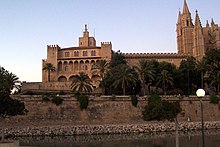
Royal Palace of La Almudaina, built in 1309 over an earlier castle.
In 1391, anti-Jewish riots broke out. The Jewish community of Inca was completely wiped out, as were those of Sóller, Sineu, and Alcudia. In spite of the governor's prohibition on leaving the island, many Jews fled to North Africa. The remaining Jews were forced to convert under threat of death.[4]
Abraham Cresques was a 14th-century Jewish cartographer of the Majorcan cartographic school from Palma; Cresques is credited with the authorship of the famous Catalan Atlas.
The river that cut through the city gave rise to two distinct areas within the city; the "Upper town" and "Lower town", depending upon which side of the river one was situated.

Palma's Silk Exchange, a masterpiece of the Gothic architecture in Majorca. Built between 1420 and 1452.
The city's advantageous geographical location allowed it extensive commerce with Catalonia, Valencia, Provence, the Maghreb, the Italian republics and the dominions of the Great Turk, which heralded a golden age for the city.
At the beginning of the 16th century, the Rebellion of the Brotherhoods (a peasant uprising against Charles V's administration) and the frequent attack of Turkish and Berber pirates caused a reduction of commercial activities and a huge inversion in defensive structures. As a consequence, the city entered a period of decadence that would last till the end of the 17th century.
17th to 19th centuries

The tower of Porto Pí
The 17th century is characterised by the division of the city in two sides or gangs, named Canamunts and Canavalls (from Majorcan Catalan "the ones from the upper/lower side"), with severe social and economical repercussions. During this period the port became a haven for pirates. During the last quarter of the century, the Inquisition continued its persecution of the city's Jews, locally called xuetes.
The fall of Barcelona in 1714 meant the end of the War of the Spanish Succession and the defeat and destruction of the Crown of Aragon, and this was reflected on the Nueva Planta decrees, issued by Philip V of Spain in 1715. These occupation decrees changed the government of the island and separated it from the municipality's government of Palma, which became the official city name. By the end of the 19th century, the name Palma de Mallorca was generalised in written Spanish, although it is still colloquially named Ciutat ("city") in Catalan. In the 18th century Charles III of Spain removed interdiction of commerce with Spanish colonies in America and the port and commercial activity of the city grew once again.
At the beginning of the 19th century, Palma became a refuge for many who had exiled themselves from the Napoleonic occupation of Catalonia and Valencia; during this period freedom flourished, until the absolutist restoration. With the establishment of contemporary Spanish state administrative organization, Palma became the capital of the new province of Balearic Islands in the 1833 territorial division of Spain. The French occupation of Algeria in the 19th century ended the fear of Maghrebi attacks in Majorca, which favoured the expansion of new maritime routes, and consequently, the economic growth of the city.
Modern period

City council of Palma
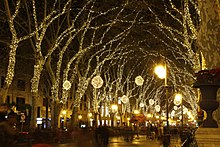
Palma in Christmas
Since the advent of mass tourism in the 1950s, the city has been transformed into a tourist destination and has attracted many workers from mainland Spain. This has contributed to a huge change in the city's traditions, its language, and its economic power.
The boom in tourism has caused Palma to grow significantly. In 1960, Mallorca received 500,000 visitors, in 1997 it received more than 6,739,700. In 2001 more than 19,200,000 people passed through Son Sant Joan airport near Palma, with an additional 1.5 million coming by sea.
In the 21st century, urban redevelopment, by the so-called Pla Mirall (English "Mirror Plan"), had attracted groups of immigrant workers from outside the European Union, especially from Africa and South America.
More than half of the population works in tourism, approximately 80%, therefore being the main economic portal of Palma. Tourism has affected the rapid economic growth of Palma, making the island of Mallorca wealthier compared to other regions in Spain.
The second economic portal of Palma is agriculture. Main exports of Palma's agriculture are, almonds, oranges, lemons and olives. The island is also gifted with a wide variety of natural resources, such as mines of copper, lead and marble.[5]
The city also has several surrounding neighborhood communities including Establiments, Nord, Son Espanyol, Ces Cases Noves, and Sa Creu Vermella.[6]
Geography

Palma pictured from the International Space Station
Palma is a major city and seaport located in the southwest of Mallorca, a western mediterranean island belonging to the Balearic Islands archipelago. The land area of the city is about 21.355 square kilometres (8.245 sq mi) with an altitude of 13 metres (43 feet) above sea level.
The city center of Palma is located north of the homonymous bay (Badia de Palma in the local Catalan language). The area that extends eastwards is mostly a flat fertile plain known as Es Pla. To the north and west, the city borders the Serra de Tramuntana, the island's major mountain range and a Unesco World Heritage site.
Population

Population of Palma (1900-2006)
As of the 2009[update]census, the population of the city of Palma proper was 401,270,[citation needed] and the population of the entire urban area was 550,000,[1] making it the twelfth largest urban area of Spain. Almost half of the total population of Mallorca live in Palma.
As of 2017[update] over 60,000 non-Spanish foreigners registered with the town hall lived in Palma; the registered foreign population from 2016 to 2017 declined by 832, the numerically highest decline in the Balearics.[7]
Climate
Palma has a Mediterranean climate, the climate classification named after the sea surrounding the city. There is a significant marine influence to warm winters, but summers are warmed by the surrounding continental landmasses.
| ||||||||||||||||||||||||||||||||||||||||||||||||||||||||||||||||||||||||||||||||||||||||||||||||||||||||||||||||||||||||||||||||||||||||||||||||||||||||||||||||||||||||
| ||||||||||||||||||||||||||||||||||||||||||||||||||||||||||||||||||||||||||||||||||||||||||||||||||||||||||||||||||||||||||||||||||||||||||||||||||||||||||||||||||||||||
Main sights
Plaça d'Espanya
The Plaça d'Espanya is the transport hub of Palma. The Estació Intermodal caters for buses and trains (the latter controlled by TIB). The two old buildings are home to the tourist information centre and several cafés sit either side of the two large escalators which lead into the Estació, which sits underneath a large and popular park. On the lawns are several glass boxes, which let in light and ventilation to the station below ground. There are also train-themed playing structures, each one shaped like a train carriage and named after towns along the line of the Ferrocarril de Sóller, a railway dating back to 1911 which has its Palma Station right next to the park. Just down the street from here a new bus station is under construction. At the centre of the plaza is a statue of James I, Conquistador of Majorca.[11]
Cathedral area
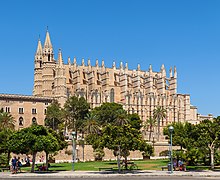
La Seu, Palma Cathedral, built between 1229 and 1346.
Palma is famous for La Seu, its vast cathedral built on a previous mosque which was built atop an original Christian church. Although construction of the present Cathedral began in 1229, it did not finish until 1601. Local architect Antoni Gaudí was drafted in to restore the building in 1901. The Parc de la Mar (Park of the Sea) lies just south, overlooked by the great building which sits above it on the city's stone foundations. Between the two are the town walls.
The Rocks
The rocks located a short walk from the cathedral are a place of calm and tranquility.
Old city

Street in Palma's Old City
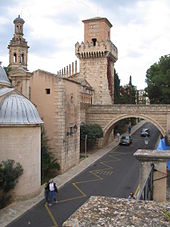
El Pueblo Español
The Old City (in the south-east area of Palma behind the cathedral) is a maze of streets clearly hinting at an Arab past.[citation needed] With the exception of a few streets and squares which allow traffic and are populated with tourists most of the time, the walkways of this city quarter are fairly narrow, quiet streets, surrounded by a diverse range of interesting buildings, the architecture of which is comparable to cities such as Florence. The majority are private houses, some of which are open to the public as discreet museums or galleries. The Old City is also home to the Ajuntament (or Town Hall), the Convent of the Cathedral and the Banys Àrabs.
Banys Àrabs

The ancient mills of El Jonquet
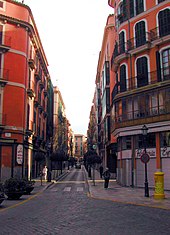
Colom street (which connects the city hall building with the Plaza Mayor)
The Banys Àrabs, or Arab Baths, one of the few remnants of Palma's Moorish past, are accessed via the quiet Ca'n Serra street near the Convent of the Cathedral, and include the lush gardens of Ca'n Fontirroig, home to Sardinian warblers, house sparrows, cacti, palm trees and a wide range of flowers and ferns. The small two-roomed brick building that once housed the baths is of Byzantine origin, dating back to the 11th century and possibly once part of the home of a Muslim nobleman. The bathroom has a cupola with five oculi which let in dazzling light. The twelve columns holding up the small room were pillaged from an earlier Roman construction. The floor over the hypocaust has been worn away by people standing in the centre, mainly to photograph the entrance and the garden beyond it. The whole room is in a rather dilapidated condition. The other room is a brick cube with a small model of the baths as they once were in the corner.
Notable people
Notable people who were born in the city include the following individuals.
Álex Abrines, basketball player for the Oklahoma City Thunder
Marco Asensio, footballer for Real Madrid
- Katie Hall- Famous Model[citation needed]
Concha Buika, singer
Rudy Fernández, basketball player for Real Madrid
Ramon Llull, philosopher and writer
Jorge Lorenzo, motorcyclist and multiple MotoGP champion
Guillermo Pont, footballer
Luis Salom, motorcyclist
Agustí Villaronga, filmmaker
Rossy de Palma, actress
Sports

Iberostar Stadium
Football is the most popular sport on the island, led by the Palma-based Segunda División B clubs Real Mallorca, who play at the Iberostar Stadium, and CD Atlético Baleares.
Basketball is also a popular sport. Palma's top team is CB Bahía San Agustín, which plays its home games at the 5,076 capacity Palau Municipal d'Esports Son Moix.
Because of its maritime location all sea sports have also a big presence in Palma. Maybe the most important sporting event in the city is the Ciutat de Palma Prizes.
Road cycling is very popular in Mallorca. An international race for professional cyclists, the Vuelta a Mallorca, is held in February, the first day of which consists of a circuit race around the streets of Palma. The city is also home to the Palma Arena, a multi-platinum venue featuring a velodrome. The arena also hosted the Battle of Surfaces tennis event.
In June 2016, the city of Palma participated in the First World Company Sports Games which included five days of culture, sport and inclusivity within the community of Mallorca as a whole. It was operated through the World Federation Company Sport and was promoted for both local people and tourists to come together in the city. It became a large business venture by offering packages including accommodations close to the events and additional tourism information for future events.[12]
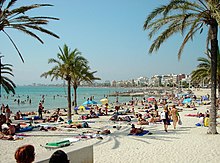
Platja de Palma in El Arenal
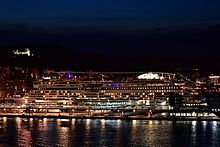
Marina at night
Transport

Correfocs in Palma
- Palma de Mallorca Metro
- Majorca rail network
- Palma de Mallorca Airport
- The city bus system, which includes a loop line through the historic centre, is run by the EMT (See external link below).
- There is also a bus system run by the TIB. This includes routes to and from the municipalities Calvià and Palma.
- In the City of Palma there is a fleet of 1246 taxis. All equipped with air conditioning and most of them have a radiotelephone station, with four existing companies: Taxis Palma Radio, Radio-Taxi Ciutat, Taxi Teléfono and Taxis adapted for users with reduced mobility. Until the change of colour regulated through the Municipal Decree No. 19985 of 15 October 1999, the taxis of Palma for 50 years had been of the characteristic black and ivory colours. Currently they are white.
Twin towns — sister cities
Palma de Mallorca is twinned with:
 Naples, Italy[13]
Naples, Italy[13]
See also
- Duchess of Palma de Mallorca
Edwin Lewis Snyder, "Spain's Magic Island", The Architect and Engineer, 110:10, 37-45, August 1932- List of municipalities in Balearic Islands
Notes
^ ab "Demographia: World Urban Areas — April 2017" (PDF) (13th Annual ed.). Archived from the original on 17 May 2017.CS1 maint: Unfit url (link).mw-parser-output cite.citation{font-style:inherit}.mw-parser-output .citation q{quotes:"""""""'""'"}.mw-parser-output .citation .cs1-lock-free a{background:url("//upload.wikimedia.org/wikipedia/commons/thumb/6/65/Lock-green.svg/9px-Lock-green.svg.png")no-repeat;background-position:right .1em center}.mw-parser-output .citation .cs1-lock-limited a,.mw-parser-output .citation .cs1-lock-registration a{background:url("//upload.wikimedia.org/wikipedia/commons/thumb/d/d6/Lock-gray-alt-2.svg/9px-Lock-gray-alt-2.svg.png")no-repeat;background-position:right .1em center}.mw-parser-output .citation .cs1-lock-subscription a{background:url("//upload.wikimedia.org/wikipedia/commons/thumb/a/aa/Lock-red-alt-2.svg/9px-Lock-red-alt-2.svg.png")no-repeat;background-position:right .1em center}.mw-parser-output .cs1-subscription,.mw-parser-output .cs1-registration{color:#555}.mw-parser-output .cs1-subscription span,.mw-parser-output .cs1-registration span{border-bottom:1px dotted;cursor:help}.mw-parser-output .cs1-ws-icon a{background:url("//upload.wikimedia.org/wikipedia/commons/thumb/4/4c/Wikisource-logo.svg/12px-Wikisource-logo.svg.png")no-repeat;background-position:right .1em center}.mw-parser-output code.cs1-code{color:inherit;background:inherit;border:inherit;padding:inherit}.mw-parser-output .cs1-hidden-error{display:none;font-size:100%}.mw-parser-output .cs1-visible-error{font-size:100%}.mw-parser-output .cs1-maint{display:none;color:#33aa33;margin-left:0.3em}.mw-parser-output .cs1-subscription,.mw-parser-output .cs1-registration,.mw-parser-output .cs1-format{font-size:95%}.mw-parser-output .cs1-kern-left,.mw-parser-output .cs1-kern-wl-left{padding-left:0.2em}.mw-parser-output .cs1-kern-right,.mw-parser-output .cs1-kern-wl-right{padding-right:0.2em}
^ Since December 2016 the city is officially "Palma", "Llei 15/2016, de 2 de desembre, de modificació de la Llei 23/2006, de 20 de desembre, de capitalitat de Palma de Mallorca" [Law 15/2016, of 2 December, of modification of Law 23/2006 of 20 December, capital of Palma de Mallorca] (in Catalan). Govern de les Illes Balears.
^ "Palma de Mallorca?" (in Catalan). Bibiloni.net. Retrieved 10 April 2011.
^ "Majorca". Jewish Virtual Library.
^ "Majorca Economy - Information on Business and Investment in Majorca". www.majorca.com. Retrieved 14 November 2016.
^ "Google Maps". Google Maps. Retrieved 12 January 2017.
^ "British and German foreign communities decreasing". Majorca Daily Bulletin. 19 January 2018. Retrieved 31 August 2018.
^ "Guía resumida del clima en España (1981-2010)".
^ "Palma de Mallorca Sea Temperature". seatemperature.org. Retrieved 15 March 2017.
^ "Palma, Spain - Climate data". Weather Atlas. Retrieved 15 March 2017.
^ Tisdall, Nigel (2003). Mallorca. Section 1 – Plaça d'Espanya – description of statue of James I. Thomas Cook Publisher. p. 48. ISBN 9781841573274.
^ "Welcome | Mallorca 2016 First World Company Sport Games". wcsgmallorca2016.com. Retrieved 14 November 2016.
^ Vacca, Maria Luisa. "Comune di Napoli - Gemellaggi" [Naples - Twin Towns]. Comune di Napoli (in Italian). Archived from the original on 22 July 2013. Retrieved 8 August 2013.
Bibliography
External links
| Wikivoyage has a travel guide for Palma de Mallorca. |
| Wikimedia Commons has media related to Palma de Mallorca. |
- Palma de Mallorca´s city council
- Official Website for Tourism in Mallorca

